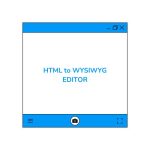From HTML to WYSIWYG: A Beginner’s Guide to Web Design
- Posted on
- By Justin Imperial
- In General,
Table of contents
- Moving from HTML to WYSIWYG
- Understanding HTML
- Advantages:
- Disadvantages:
- Introduction to WYSIWYG editors
- Benefits of using WYSIWYG for web design:
- Comparison between HTML and WYSIWYG editors
- HTML Coding
- WYSIWYG Editors
- Start From HTML to WYSIWYG editor Pro
- Basic features and tools to look for in a WYSIWYG editor include:
- Advanced techniques in WYSIWYG editors
- Search Engine Optimization with a WYSIWYG Editor
- Tips for successful web design with a WYSIWYG editor
- Tips to keep in mind:
- Common mistakes to avoid:
- Conclusion

Moving from HTML to WYSIWYG
Maybe you’re a web developer with tight deadlines or maybe you’re not even a developer but would want to learn how to quickly publish on the web. Either way, you want to take advantage of WYSIWYG editors. Many traditional developers would argue that manually coding each line is still the best and quite frankly, it still is. However, if you’re in a rush that simply isn’t the best way to produce quality results. And if you’re a student who is new to web design, maybe you don’t want to fully handle coding either. And that’s okay. If you think you will be frowned upon since you use drag-and-drop functionality, at the end of the day, your clients and users wouldn’t even know how you built the website and if it looks good and optimized, then who cares how you built it. So let’s get from traditional HTML to WYSIWYG wiz!
So if you want to have a presence online, not only do you need social media, but you also need a website. Social media has tremendous perks. Despite having a presence on social media, you may not have complete control over the content you publish. The website’s owner retains the final say on what type of content is acceptable and what is not. So if you need something fully customizable for your clients, users, and investors to take your business seriously, you absolutely need a website. So let’s learn to simplify workflow with WYSIWYG editors and go from HTML to WYSIWYG.
Understanding HTML
HTML, also known as Hypertext Markup Language, is commonly utilized in websites and applications, with its greatest recognition coming from website design. HTML content consists of tags enclosed in angled brackets. Pretty simple, right? But you can do a lot with these. These tell how it will display content. This content is mostly text. However, you can further customize the text and add headings, paragraphs, images, links, forms, applications, and many more. HTML coding is very versatile in this case.
HTML is originally and traditionally written in a text editor. You can use a very simple one such as Notepad or use a sophisticated one like Visual Studio Code. Once completed, the files are saved with a .html extension so that browsers can recognize and display them on the internet.
Advantages:
- Compatibility: HTML is supported by all major platforms. These are web browsers and operating systems. Thus, making it a universal language for web design.
- Easy to learn: HTML is pretty straightforward. It has a simple syntax which is easy for beginners.
- Flexibility: HTML can be combined with other languages and tools. Popular ones are CSS and JavaScript. These 3 are the major ones and enough to create complex web applications.
- Search engine optimization (SEO): HTML is optimized for search engines like Google. This means it is easier for search engines to crawl and index pages.
- Accessibility: HTML is pretty accessible to users with disabilities by adding accessibility features. These are alt tags for images and aria labels for interactive elements.
Disadvantages:
- Limited interactivity: This is a static language, which means it can only create static web pages. This means it has limited interactivity. To enhance the functionality and aesthetics of HTML, it is commonly used in conjunction with CSS and JavaScript.
- Limited design options: It is limited with options for design and layout. This makes it challenging to create complex designs.
- Steep learning Curve: While HTML is easy to learn for basic web design, advanced features require more knowledge and experience.
- Accessibility challenges: HTML can be used to create accessible web pages but it comes with its caveats. It still requires additional effort in ensuring full accessibility.
Introduction to WYSIWYG editors
A WYSIWYG HTML editor allows users to create and edit web pages visually. This means you don’t need to know HTML or CSS. So if you’re a beginner this would tremendously benefit you. It displays the web page in a simple interface. By providing a preview of the page, users can see precisely how it will appear once published. Without code knowledge, users can then edit the content by using the editor. Perhaps one of the most popular tools is the drag-and-drop feature. The color pickers and font selectors make it look like you’re just using Microsoft Word too.
Benefits of using WYSIWYG for web design:
- User-friendly: They are user-friendly in that they provide a visual interface that is easy to use. Thus, making it an ideal tool for novice users with little to no coding experience.
- Quick and Fast: It saves time and effort by removing the need to manually type code. This means you can create web pages quickly.
- Accessible: It makes web pages more accessible. By providing tools for adding alt text to images and other multimedia elements, people with disabilities are able to appreciate the content.
- Consistent: By providing templates and design elements that can be used repeatedly, these editors ensure it’s consistent across web pages. The themes and templates maintain a consistent look and feel across the website.
- Customization: Customization options allow developers to modify the editor. This means if they need a certain feature, they can make sure the editor is able to do so. A lightweight customization setup is usually included on a lot of editors.
Comparison between HTML and WYSIWYG editors
Going from HTML to WYSIWYG can probably be confusing so let’s help you. Here’s a side by side comparison of both:
HTML Coding |
WYSIWYG Editors |
|---|---|
|
|
|
|
|
|
|
|
|
|
|
|
|
|
|
|
|
|
|
|
Start From HTML to WYSIWYG editor Pro
To create visually appealing content quickly, even without extensive coding knowledge, getting started with a WYSIWYG editor can be an excellent option. However, choosing the right editor is crucial.
You should consider the type of content you plan to make when you choose a WYSIWYG editor. Some are better suited for web design, while others are great in other areas. Some editors offer more advanced features, while others are much more simple and geared towards beginners.
Basic features and tools to look for in a WYSIWYG editor include:
- Drag-and-drop functionality: Arguably one of the favorite features of beginners. This ability saves time and simplifies the development process.
- Text Editor: These tools allow users to modify text mainly. However, a lot of editors allow the modification of images, videos and other elements as well.
- Pre-designed templates: Another personal favorite of mine. Pre-made templates gives you a general theme for your web page in just minutes. This is prevalent across all web pages giving uniformity and consistency.
- Responsive: Everyone’s on their mobile devices nowadays. Responsive design is essential if you want your mobile users to access your pages. Most editors now have responsive temples so this should be quite easy to implement.
- Tool integration: Advanced features require you to integrate your editor with other tools. Having the ability to integrate with tools like social media plugins or email marketing software can improve user experience and reach a larger audience.
Advanced techniques in WYSIWYG editors
Here are some techniques and features that can take your web design skills to go from HTML to WYSIWYG expert:
- Custom Code: Custom code snippets, such as CSS, HTML, or JavaScript, that are inputted directly into the editor allows for more usability. Explore this function and you can do more even with a simple editor.
- Responsive Design: Make sure that your editor is capable of designing a responsive page so it can be accessed on all devices and platforms.
- Templates and Libraries: Pre-built templates and libraries make adding new features a breeze. Explore your editors library provide new functions for your website.
- Code View: To further tweak your design, you can try the code view feature. For example, to incorporate programming languages such as JavaScript, editors offer a code view which allows developers to edit the code directly. Using the code view, gives developers tremendous control over the design much like traditional coding does.
Search Engine Optimization with a WYSIWYG Editor
Optimizing content for search engines like Bing and Google is essential for website ranking. No use in making the best design if no one can see it, right? So here are some tips for SEO:
- Make use of descriptive text.
- Header tags in structuring content improves readability.
- You are not using enough subheadings.
- Use alt tags for images.
- Make the page load fast by optimizing the code.
- External links to authoritative websites improves content quality.
Tips for successful web design with a WYSIWYG editor
Tips to keep in mind:
- Plan and organize: Before you even start designing from HTML to WYSIWYG, it’s important to plan. Have at least an outline of your content. The outline will give you an idea of the structure and layout of your content.
- Consistent design: Consistency is key in looking professional (even if you are not). A consistent design will make you look like an authority and your visitors will take your content seriously. Use the same fonts, colors, styles, theme and design.
- Simplicity: Clutter is a no no. Keep your website simple and straight to the point. Users will then be able to find the information they need quickly and easily.
- White space: Empty space is still design. It helps the user’s eyes breathe. Ever heard of minimalism? This makes your website look more organized and easier to read. If you’re not good at designing, use less and simple designs with white space. It will still look professional.
- High-quality images: Images are an important part of web design as we humans are very visual. High-quality images provide more context and keep your readers engaged. JPEG is usually one of the best formats to use. PNG can be used too if you’re using images with no backgrounds. However, JPEG is the best for both quality and size.
Common mistakes to avoid:
- Too much design: Is there such a thing as too much design? Yes, there is. Using too many design elements can make your website look cluttered and overwhelming. It will look unprofessional unless that’s exactly the look you’re going for.
- Not Responsive: Most of us are on our phones 24/7. Heck, you’re probably reading this on your phone as well. Need I say more? Don’t ignore mobile users.
- Not optimized for SEO: You probably found this website through Google. Don’t underestimate the power of search engines. Yes, social media helps in marketing products and articles such as these but a big chunk of your audience will be from search engines.
- Too many different fonts and colors: Same with having too much design, sometimes too much is just too much. Your eyes need a break and intense design is useless if it breaks functionality. No point in having fancy colors and fonts if the reader can’t even read or understand what you wrote.
Conclusion
So by now you’re probably wondering so which should I use? Well both have advantages and disadvantages as we’ve previously discussed. However, you don’t have to necessarily use one or the other so you don’t have to move from HTML to WYSIWG entirely. They could be used in harmoniously together as well. Some WYSIWYG editors incorporated code view and nowadays, it’s a necessity. Here at Froala, we make content creation easy with our own WYSIWYG editor. If you want to learn how to use it, here are some quick tips to use Froala. Froala also has WYSIWYG powerful tools. So try out these editors and keep in mind the tips, common mistakes, pros and cons of it and you’ll be making your amazing website in no time!
Justin Imperial
Justin is a web developer, writer, graphic designer and everything in between! He loves technology, philosophy, astronomy and more. He loves learning new thins and his curiosity is insatiable. On his free time, you can find him isolating himself while reading a book or playing video games or out with his friends.
-
Hide Show








No comment yet, add your voice below!